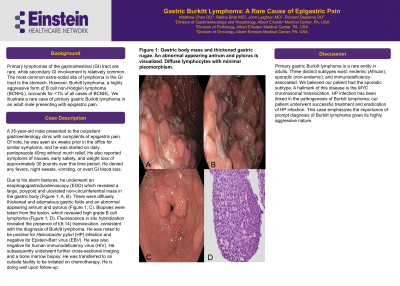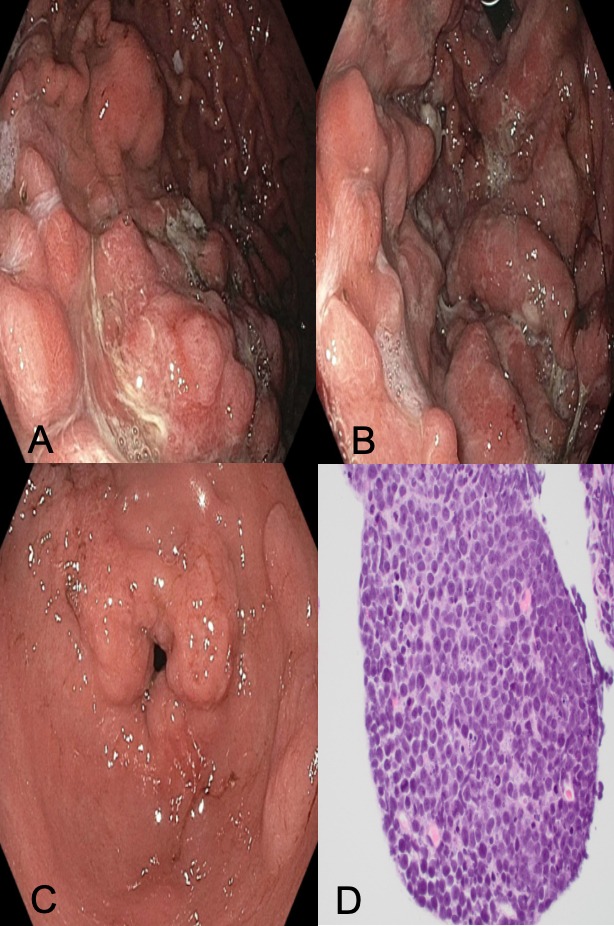Monday Poster Session
Category: Stomach
P2774 - Gastric Burkitt Lymphoma: A Rare Cause of Epigastric Pain
Monday, October 23, 2023
10:30 AM - 4:15 PM PT
Location: Exhibit Hall

Has Audio

Matthew Chan, DO
Albert Einstein Medical Center
Philadelphia, PA
Presenting Author(s)
Matthew Chan, DO, Rekha Bhat, MD, John Leighton, MD, Richard Depalma, DO
Albert Einstein Medical Center, Philadelphia, PA
Introduction: Primary lymphomas of the gastrointestinal (GI) tract are rare, while secondary GI involvement is relatively common. The most common extra-nodal site of lymphoma in the GI tract is the stomach. However, Burkitt lymphoma, a highly aggressive form of B cell non-Hodgkin lymphoma (BCNHL), accounts for < 1% of all cases of BCNHL. We illustrate a rare case of primary gastric Burkitt lymphoma in an adult male presenting with epigastric pain.
Case Description/Methods: A 35-year-old male presented to the outpatient gastroenterology clinic with complaints of epigastric pain. Of note, he was seen six weeks prior in the office for similar symptoms, and he was started on daily pantoprazole 40mg without much relief. He also reported symptoms of nausea, early satiety, and weight loss of approximately 30 pounds over this time period. He denied any fevers, night sweats, vomiting, or overt GI blood loss.
Due to his alarm features, he underwent an esophagogastroduodenoscopy (EGD) which revealed a large, polypoid and ulcerated non-circumferential mass in the gastric body (Figure 1; A, B). There were diffusely thickened and edematous gastric folds and an abnormal appearing antrum and pylorus (Figure 1; C). Biopsies were taken from the lesion, which revealed high grade B cell lymphoma (Figure 1; D). Fluorescence in situ hybridization revealed the presence of t(8;14) translocation, consistent with the diagnosis of Burkitt lymphoma. He was noted to be positive for Helicobacter pylori (HP) infection and negative for Epstein-Barr virus (EBV). He was also negative for human immunodeficiency virus (HIV). He subsequently underwent further cross-sectional imaging and a bone marrow biopsy. He was transferred to an outside facility to be initiated on chemotherapy. He is doing well upon follow-up.
Discussion: Primary gastric Burkitt lymphoma is a rare entity in adults. Three distinct subtypes exist: endemic (African), sporadic (non-endemic), and immunodeficiency-associated. We believed our patient had the sporadic subtype. A hallmark of this disease is the MYC chromosomal translocation. HP infection has been linked in the pathogenesis of Burkitt lymphoma; our patient underwent successful treatment and eradication of HP infection. This case emphasizes the importance of prompt diagnosis of Burkitt lymphoma given its highly aggressive nature.

Disclosures:
Matthew Chan, DO, Rekha Bhat, MD, John Leighton, MD, Richard Depalma, DO. P2774 - Gastric Burkitt Lymphoma: A Rare Cause of Epigastric Pain, ACG 2023 Annual Scientific Meeting Abstracts. Vancouver, BC, Canada: American College of Gastroenterology.
Albert Einstein Medical Center, Philadelphia, PA
Introduction: Primary lymphomas of the gastrointestinal (GI) tract are rare, while secondary GI involvement is relatively common. The most common extra-nodal site of lymphoma in the GI tract is the stomach. However, Burkitt lymphoma, a highly aggressive form of B cell non-Hodgkin lymphoma (BCNHL), accounts for < 1% of all cases of BCNHL. We illustrate a rare case of primary gastric Burkitt lymphoma in an adult male presenting with epigastric pain.
Case Description/Methods: A 35-year-old male presented to the outpatient gastroenterology clinic with complaints of epigastric pain. Of note, he was seen six weeks prior in the office for similar symptoms, and he was started on daily pantoprazole 40mg without much relief. He also reported symptoms of nausea, early satiety, and weight loss of approximately 30 pounds over this time period. He denied any fevers, night sweats, vomiting, or overt GI blood loss.
Due to his alarm features, he underwent an esophagogastroduodenoscopy (EGD) which revealed a large, polypoid and ulcerated non-circumferential mass in the gastric body (Figure 1; A, B). There were diffusely thickened and edematous gastric folds and an abnormal appearing antrum and pylorus (Figure 1; C). Biopsies were taken from the lesion, which revealed high grade B cell lymphoma (Figure 1; D). Fluorescence in situ hybridization revealed the presence of t(8;14) translocation, consistent with the diagnosis of Burkitt lymphoma. He was noted to be positive for Helicobacter pylori (HP) infection and negative for Epstein-Barr virus (EBV). He was also negative for human immunodeficiency virus (HIV). He subsequently underwent further cross-sectional imaging and a bone marrow biopsy. He was transferred to an outside facility to be initiated on chemotherapy. He is doing well upon follow-up.
Discussion: Primary gastric Burkitt lymphoma is a rare entity in adults. Three distinct subtypes exist: endemic (African), sporadic (non-endemic), and immunodeficiency-associated. We believed our patient had the sporadic subtype. A hallmark of this disease is the MYC chromosomal translocation. HP infection has been linked in the pathogenesis of Burkitt lymphoma; our patient underwent successful treatment and eradication of HP infection. This case emphasizes the importance of prompt diagnosis of Burkitt lymphoma given its highly aggressive nature.

Figure: Figure 1: Gastric body mass and thickened gastric rugae. An abnormal appearing antrum and pylorus is visualized. Diffuse lymphocytes with minimal pleomorphism.
Disclosures:
Matthew Chan indicated no relevant financial relationships.
Rekha Bhat indicated no relevant financial relationships.
John Leighton indicated no relevant financial relationships.
Richard Depalma indicated no relevant financial relationships.
Matthew Chan, DO, Rekha Bhat, MD, John Leighton, MD, Richard Depalma, DO. P2774 - Gastric Burkitt Lymphoma: A Rare Cause of Epigastric Pain, ACG 2023 Annual Scientific Meeting Abstracts. Vancouver, BC, Canada: American College of Gastroenterology.
